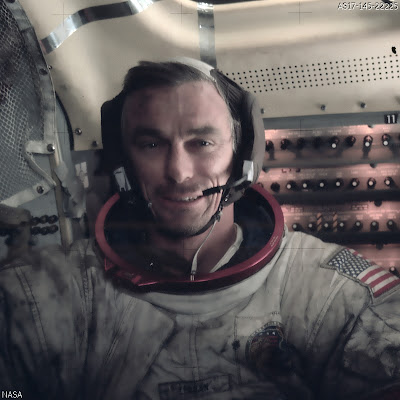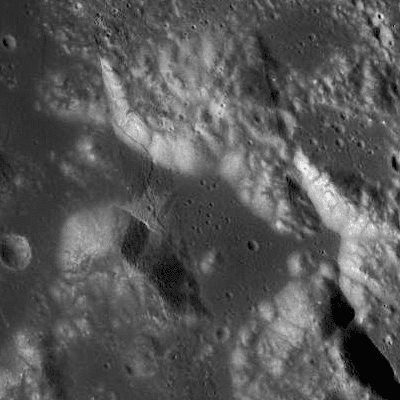Apollo 17 commander Gene Cernan, back in the Lunar Module Challenger, is photographed by LM pilot Harrison Schmitt completing a total 22 hours, 6 minutes, 45 seconds on the lunar surface at the end of EVA-3, December 14, 1972 [NASA/ALSJ].
Michael Shinabery
New Mexico Museum of Space History
Alamogordo Daily News
During early spaceflights, little things alleviated big frustrations.
"We had to take some chewing gum, Dentyne chewing gum, on Gemini IX, just to keep our mouth refreshed," Gene Cernan said in a 2007 NASA oral history. "We couldn't take toothpaste and toothbrushes, because what are you going to do with the toothpaste? Well, we're going to swallow it. Oh, you can't swallow it."
Cernan, born on March 14, 1934, made three spaceflights, his final one as Apollo 17 commander. Before climbing into the lunar module Challenger, he left man's last footprints on the Moon.
"We leave as we came and, God willing, we shall return with peace and hope for all mankind," The Associated Press reported Cernan said.
"I never even thought about (my words) until I was crawling up, basically crawling up the ladder," Cernan said in the Dec. 11, 2007 oral history, on the 35th anniversary of his lunar landing.
Cernan was at Purdue University when he "received his commission through the Navy ROTC Program," the website jsc.nasa.gov said. In October 1963 NASA chose him among 14 astronauts. In 1966 he piloted Gemini IX, becoming "the second American to walk in space"; he was outside the capsule for two hours and 10 minutes. Subsequently, he was "backup pilot for Gemini 12 and ... backup lunar module pilot for Apollo 7," and later " backup spacecraft commander for Apollo 14."
Cernan's second flight was in May 1969, as Apollo 10 LM pilot. He descended "to within (eight) nautical miles of the lunar surface," jsc.nasa.gov said, "demonstrating that man could navigate safely and accurately in the moon's gravitational fields."
"We had to take some chewing gum, Dentyne chewing gum, on Gemini IX, just to keep our mouth refreshed," Gene Cernan said in a 2007 NASA oral history. "We couldn't take toothpaste and toothbrushes, because what are you going to do with the toothpaste? Well, we're going to swallow it. Oh, you can't swallow it."
Cernan, born on March 14, 1934, made three spaceflights, his final one as Apollo 17 commander. Before climbing into the lunar module Challenger, he left man's last footprints on the Moon.
"We leave as we came and, God willing, we shall return with peace and hope for all mankind," The Associated Press reported Cernan said.
"I never even thought about (my words) until I was crawling up, basically crawling up the ladder," Cernan said in the Dec. 11, 2007 oral history, on the 35th anniversary of his lunar landing.
Cernan was at Purdue University when he "received his commission through the Navy ROTC Program," the website jsc.nasa.gov said. In October 1963 NASA chose him among 14 astronauts. In 1966 he piloted Gemini IX, becoming "the second American to walk in space"; he was outside the capsule for two hours and 10 minutes. Subsequently, he was "backup pilot for Gemini 12 and ... backup lunar module pilot for Apollo 7," and later " backup spacecraft commander for Apollo 14."
Cernan's second flight was in May 1969, as Apollo 10 LM pilot. He descended "to within (eight) nautical miles of the lunar surface," jsc.nasa.gov said, "demonstrating that man could navigate safely and accurately in the moon's gravitational fields."
Taurus-Littrow Valley, skirting the eastern shore of Mare Serenitatis, the landing site of Apollo 17 as seen from the general but simulated perspective along a line-of-sight view from Earth. The pitch-over before landing took place over the mountainous terrain on the Valley's eastern side. LROC Wide Angle Camera monochrome mosaic centered at 0 degrees longitude (the lunar nearside) [NASA/GSFC/Arizona State University].
Apollo 17 launched on December 7, 1972, "the first manned nighttime launch," said jsc.nasa.gov. Four days later, Cernan and Harrison Schmitt touched down at Taurus-Littrow.
He "waited a long time for December 11, 1972 to come around," Cernan said. "I'm flying. A lot of people think we pressed a button and let the thing fly itself. There's no way I'm going to go all the way to the Moon and let a computer land me on the Moon. The arrogance of a pilot, particularly naval aviators, is too great to allow that to happen. Nobody ever landed on the Moon other than with their own two hands and brain and eyeballs."
He "waited a long time for December 11, 1972 to come around," Cernan said. "I'm flying. A lot of people think we pressed a button and let the thing fly itself. There's no way I'm going to go all the way to the Moon and let a computer land me on the Moon. The arrogance of a pilot, particularly naval aviators, is too great to allow that to happen. Nobody ever landed on the Moon other than with their own two hands and brain and eyeballs."



No comments:
Post a Comment